StarBright UltraViolet Dyes

- On This Page
- SBUV400
- SBUV445
- SBUV510
- SBUV575
- SBUV605
- SBUV665
- SBUV740
- SBUV795
- UltraViolet Antibodies
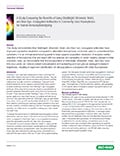 Technical Note: A Study Comparing the Benefits of Using StarBright Ultraviolet, Violet, and Blue Dye–Conjugated Antibodies to Commonly Used Fluorophores for Human Immunophenotyping
Technical Note: A Study Comparing the Benefits of Using StarBright Ultraviolet, Violet, and Blue Dye–Conjugated Antibodies to Commonly Used Fluorophores for Human Immunophenotyping
Excitable by the 355 nm laser, StarBright™ UltraViolet (SBUV) Dyes are a perfect way to expand your flow cytometry panels, giving you more flexibility in your panel design while avoiding spillover and spreading. Available with maximal emissions ranging from 400 to 800 nm, eight additional dyes are coming soon with the same exceptional properties as the other StarBright Dyes and are conjugated to our validated antibodies. Suitable for use in conventional and full spectrum flow cytometry, these bright and stable dyes can be used in any buffer and have narrow excitation and emission profiles enabling you to build bigger and better panels.
SBUV Dye Range
Table 1. StarBright UltraViolet range.
StarBright Dye |
Max Ex, nm |
Max Em, nm |
Brightness (1–5) |
ZE5 Cell Analyzer Optimal Filter |
Comparison Dye |
Flier |
|---|---|---|---|---|---|---|
|
StarBright UltraViolet 400 Dye |
335 |
394 |
4 |
387/11 |
Brilliant Ultraviolet (BUV) 395 |
|
|
StarBright UltraViolet 445 Dye |
347 |
440 |
2 |
447/60 or 460/22 |
Alexa Fluor 350, Dylight 350 |
|
|
StarBright UltraViolet 510 Dye |
340 |
513 |
2 |
509/25 or 525/50 |
BUV496 |
|
|
StarBright UltraViolet 575 Dye |
340 |
569 |
4 |
577/15 |
BUV563 |
|
|
StarBright UltraViolet 605 Dye |
340 |
609 |
4 |
615/24 |
BUV615 |
|
|
StarBright UltraViolet 665 Dye |
340 |
669 |
4 |
670/30 |
BUV661 |
|
|
StarBright UltraViolet 740 Dye |
344 |
743 |
4 |
747/33 |
BUV737 |
|
|
StarBright UltraViolet 795 Dye |
340 |
792 |
3 |
780LP |
BUV805 |
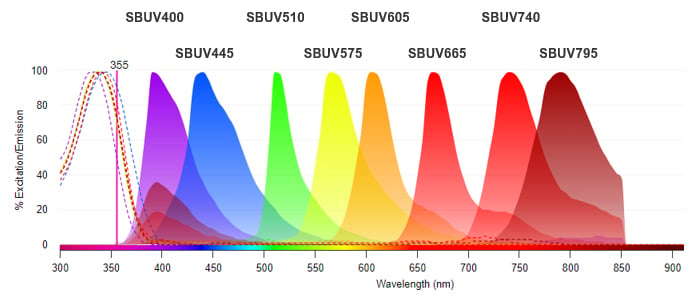
Fig. 1. Excitation and emission spectra of StarBright UltraViolet Dyes.
StarBright UltraViolet 400 (SBUV400) Dye
SBUV400 Dye is a bright, 355 nm laser excitable dye that has all the benefits of StarBright Dyes and is suitable for use in conventional and full spectrum flow cytometry (Figure 3).
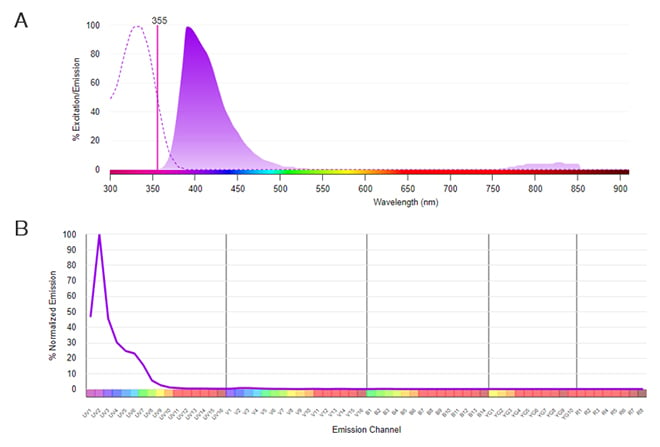
Fig. 2. SBUV400. A, Conventional spectra. Excitation by the ultraviolet laser (dotted line) with emission shown in the shaded histogram. B, Normalized dye signature. Full emission spectrum showing the emission at all wavelengths. Data were collected on a 5-L Cytek Aurora Flow Cytometry System using SpectroFlo Software.
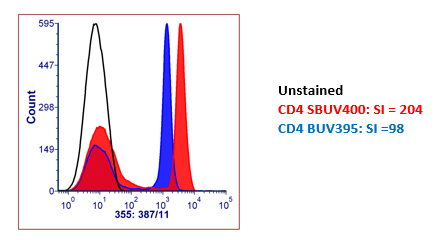
Fig 3. Brightness comparison. Human peripheral blood was stained with CD4SBUV400 (MCA1267SBUV400) or CD4BUV395. SBUV400 is twice as bright as the competitor dye. BUV, Brilliant Ultraviolet; SBUV, StarBright UltraViolet; SI, staining index.
With minimum excitation and emission into other channels, and no special buffer required, SBUV400 can be easily added to existing panels to increase panel size or replace a fluorescent dye that has spillover into other channels. Examples of SBUV400 staining with other fluorescent dyes, including StarBright Dyes, can be seen in Figure 4.
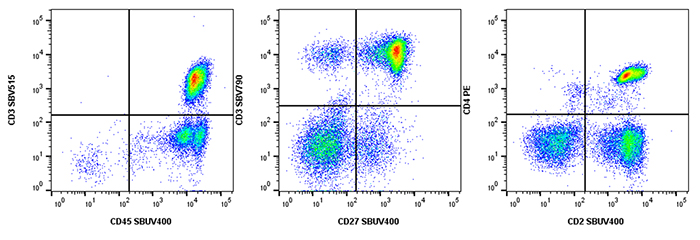
Fig. 4. Performance of SBUV Dyes. Human peripheral blood was stained with various SBUV400 labeled antibodies and counterstained with different StarBright Violet or PE labeled antibodies. Staining was performed in PBS containing 1% BSA.
StarBright UltraViolet 445 (SBUV445) Dye
SBUV445 is up to 20 times as bright as the nearest competitor dye (Figure 6) and allows clear separation of positive and negative populations, which is sometimes difficult when using competitor dyes with similar excitation and emission spectra, even with high antigen density.
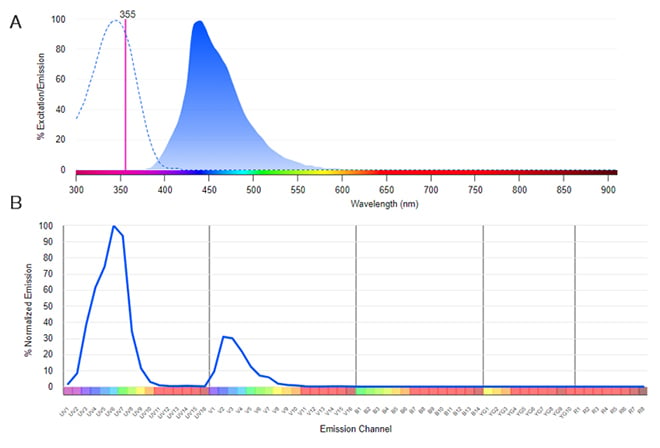
Fig. 5. SBUV445. A, Conventional spectra. Excitation by the ultraviolet laser (dotted line) with emission shown in the shaded histogram. B, Normalized dye signature. Full emission spectrum showing the emission at all wavelengths. Data were collected on a 5-L Cytek Aurora Flow Cytometry System using SpectroFlo Software.
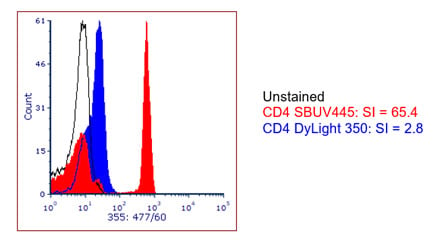
Fig. 6. Brightness comparison. Human peripheral blood was stained with CD4SBUV445 (MCA1267SBUV445) or CD4 DyLight 350. SBUV445 is over 20x as bright as the competitor dye. SBUV, StarBright UltraViolet; SI, stain index.
SBUV445 is bright enough to detect rare populations, such as murine peripheral blood NK cells, upregulated markers upon activation such as CD25, and general immunophenotyping markers like CD27 (Figure 7). It is fixable, with no special buffer required when staining, and has high lot-to-lot reproducibility. SBUV445 can be easily added to existing panels, replacing dimmer dyes for enhanced resolution. As there are no other suitable dyes emitting at this wavelength from the 355 nm UV laser, this dye allows you to follow best practice, separating your markers across all lasers and filters. Furthermore, in spectral flow cytometry, as there are no competitor dyes, SBUV445 has a low similarity score, allowing you to increase panel size without increasing the overall complexity.
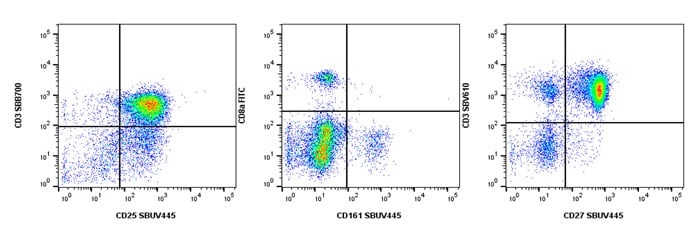
Fig. 7. Performance of SBUV445. Human peripheral blood was stained with various SBUV445 labeled antibodies and counterstained with a variety of StarBright Violet Dyes, StarBright Blue Dyes, or FITC labeled antibodies. Staining was performed in PBS containing 1% BSA with the addition of Fc block.
StarBright UltraViolet 510 (SBUV510) Dye
SBUV510 is a bright, 355 nm laser excitable dye that has all the benefits of StarBright Dyes and is suitable for use in both conventional and full spectrum flow cytometry (Figure 9).
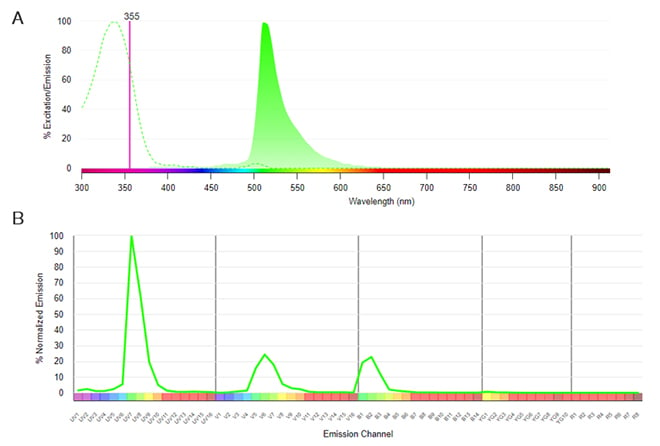
Fig. 8. SBUV510. A, Conventional spectra. Excitation by the ultraviolet laser (dotted line) with emission shown in the shaded histogram. B, Normalized dye signature. Full emission spectrum showing the emission at all wavelengths. Data were collected on a 5-L Cytek Aurora Flow Cytometry System using SpectroFlo Software.
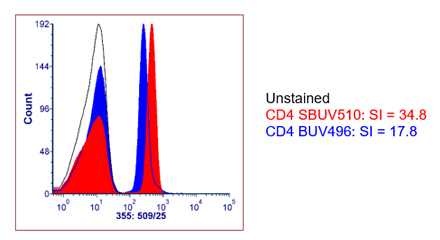
Fig. 9. Brightness comparison. Human peripheral blood was stained with CD4SBUV510 (MCA1267SBUV510) or CD4 BUV496. SBUV510 is twice as bright as the competitor dye. BUV, Brilliant Ultraviolet; SBUV, StarBright UltraViolet; SI, stain index.
SBUV510 is twice as bright as the nearest competitor dye (Figure 9) and is not a traditional tandem dye. Therefore, it has reduced signal in the channels expected from a donor dye. Fixable, with no special buffer required and lot-to-lot reproducibility compared to tandem dyes, SBUV510 can be easily added to existing panels and replace dimmer dyes for enhanced resolution.
StarBright UltraViolet 575 (SBUV575) Dye
SBUV575 is a bright, 355 nm laser excitable dye that has all the benefits of StarBright Dyes and is suitable for use in both conventional and full spectrum flow cytometry (Figure 11A). Being twice as bright as the nearest competitor dye, it is able to be used, with no special buffer, to detect antigens not found in abundance on the cell surface, such as CD28 on CD4 and CD8 T cells. (Figure 11B).
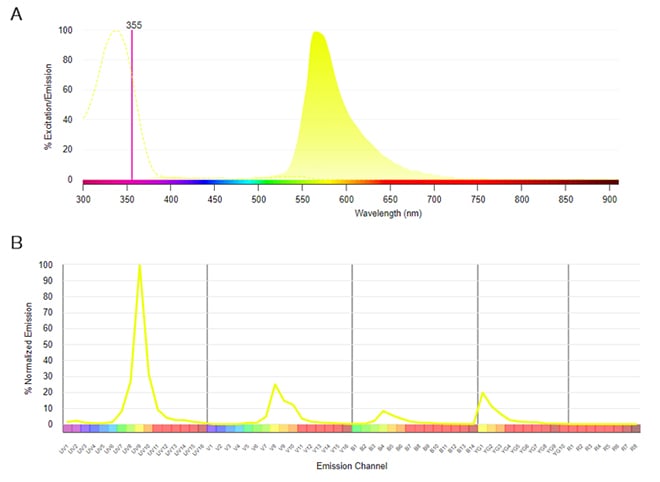
Fig. 10. SBUV575. A, Conventional spectra. Excitation by the ultraviolet laser (dotted line) with emission shown in the shaded histogram. B, Normalized dye signature. Full emission spectrum showing the emission at all wavelengths. Data were collected on a 5-L Cytek Aurora Flow Cytometry System using SpectroFlo Software.
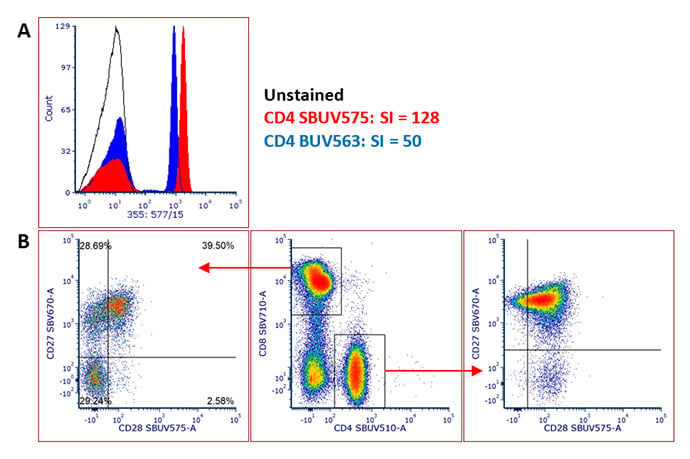
Fig. 11. A bright dye for low density markers. A, Human peripheral blood was stained with CD4SBUV575 (MCA1267SBUV575) or CD4BUV563. SBUV575 is twice as bright as the competitor dye. BUV, Brilliant Ultraviolet; SBUV, StarBright UltraViolet; SI, staining index. B, Human peripheral blood was stained with CD4SBUV510 (MCA1267SBUV510), CD8SBV710 (MCA1226SBV710), CD27SBV670 (MCA755SBV670), and CD28SBUV575 (MCA709SBUV575)
StarBright UltraViolet 605 (SBUV605) Dye
SBUV605 is a bright, 355 nm laser excitable dye that has all the benefits of StarBright Dyes and is suitable for use in both conventional and full spectrum flow cytometry (Figure 13). Being brighter than the nearest competitor dye with improved spectral characteristics, it is a perfect replacement in multicolor panels for existing dyes.
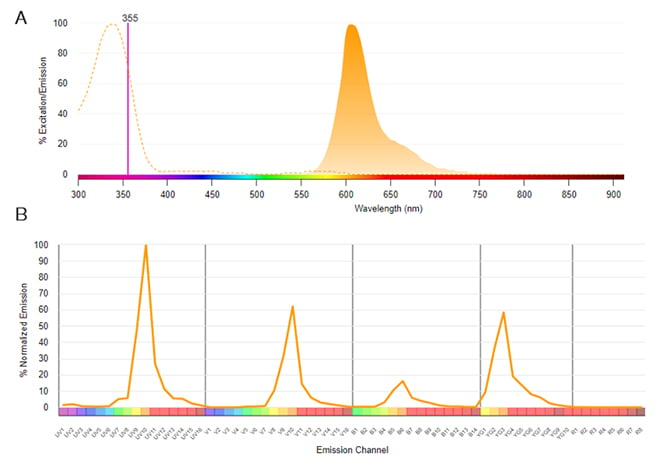
Fig. 12. SBUV605 A, Conventional spectra. Excitation by the ultraviolet laser (dotted line) with emission shown in shaded histogram. B, Normalized dye signature. Full emission spectrum showing the emission at all wavelengths. Data was collected on a 5L Cytek Aurora Flow Cytometry System using SpectroFlo Software.
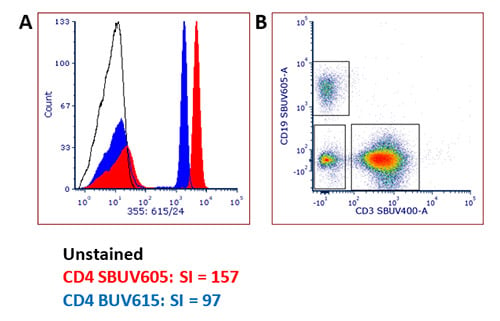
Fig. 13. Performance of SBUV605. A,
Human peripheral blood was stained with CD4SBUV605 (MCA1267SBUV605) or CD4 BUV615. SBUV605 is brighter than the competitor dye. BUV, Brilliant Ultraviolet; SBUV, StarBright UltraViolet; SI, stain index. B, Human peripheral blood was stained with CD3SBUV400 (MCA463SBUV400) and CD19SBUV605 (MCA1940SBUV605).
StarBright UltraViolet 665 (SBUV665) Dye
SBUV665 Dye is a bright, 355 nm laser excitable dye that has all the benefits of StarBright Dyes, requires no special buffer and is suitable for use in conventional and full spectrum flow cytometry (Figure 15).
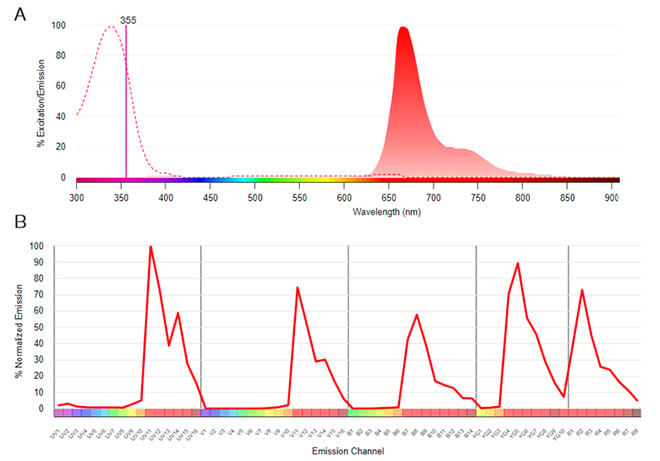
Fig. 14. SBUV665. A, Conventional spectra. Excitation by the ultraviolet laser (dotted line) with emission shown in the shaded histogram. B, Normalized dye signature. Full emission spectrum showing the emission at all wavelengths. Data were collected on a 5-L Cytek Aurora Flow Cytometry System using SpectroFlo Software.
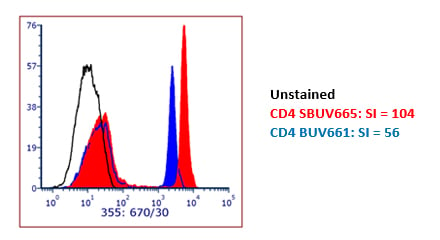
Fig. 15.
Brightness comparison. Human peripheral blood was stained with CD4SBUV665 (MCA1267SBUV665) or CD4BUV661. SBUV665 is twice as bright as the competitor dye. BUV, Brilliant Ultraviolet; SBUV, StarBright UltraViolet; SI, staining index.
Although SBUV665 exhibits reduced spillover, compared to BUV661, into Alexa Fluor 647 and Alexa Fluor 700, resolving weekly positive populations may still be an issue. You should follow panel building best practice and avoid marker combinations using dyes that can cause problems. This is demonstrated with CD127 (Figure 16), which has a broad expression range, and CD4. The CD127lo CD4hi cells are not distinguishable from CD127negCD4hi. When a marker such as CD3 is used, which does not have a CD3negCD4hi cluster, populations can be easily distinguished even when combined with Alexa Fluor 700. Spillover and spreading values are shown below (Table 2).
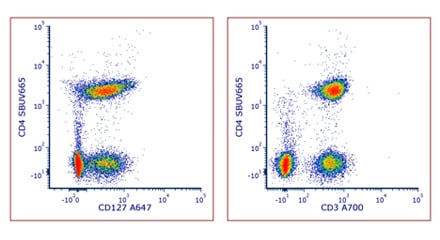
Fig. 16. Spillover considerations. Human peripheral blood was stained for CD4SBUV665 (MCA1267SBUV665), CD127A647 (HCA145A647), and CD3A700 (MCA463A700). The spillover and spreading is shown in the respective tables.
Table 2. Spillover and spreading values for SBUV665.
Spillover:
Source |
Target |
||
|---|---|---|---|
|
|
SBUV665 |
A700 |
A647 |
|
SBUV665 |
1 |
31.7% |
48.9% |
|
A700 |
0% |
1 |
1.9% |
|
A647 |
0.5% |
79% |
1 |
Spreading:
Source |
Target |
||
|---|---|---|---|
|
|
SBUV665 |
A700 |
A647 |
|
SBUV665 |
0 |
1.01 |
1.72 |
|
A700 |
0.19 |
0 |
0.29 |
|
A647 |
0.11 |
2.46 |
0 |
StarBright UltraViolet 740 (SBUV740) Dye
SBUV740 is a bright, 355 nm laser excitable dye that has all the benefits of StarBright Dyes and is suitable for use in both conventional and full spectrum flow cytometry. SBUV740 is not a traditional tandem, is twice as bright (Figure 18), and has reduced emission from the 640 nm laser compared to dyes with similar emission maxima. Furthermore, SBUV740 has a unique spectral profile making it a perfect addition to full spectrum flow cytometry panels.
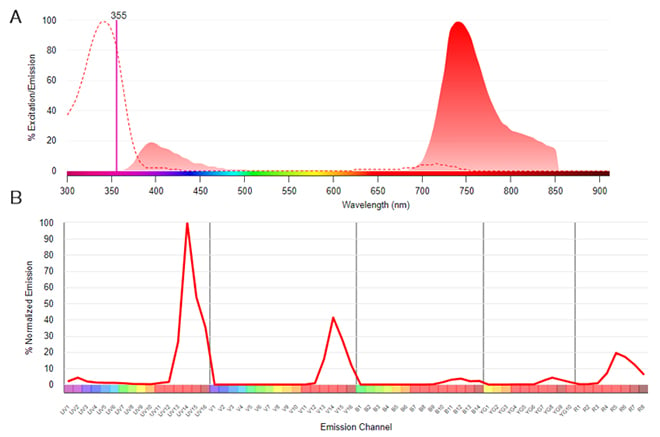
Fig. 17. SBUV740. A, Conventional spectra. Excitation by the ultraviolet laser (dotted line) with emission shown in the shaded histogram. B, Normalized dye signature. Full emission spectrum showing the emission at all wavelengths. Data were collected on a 5-L Cytek Aurora Flow Cytometry System using SpectroFlo Software.
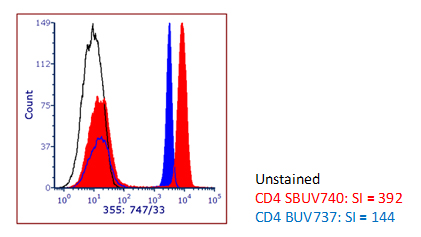
Fig. 18. Brightness comparison. Human peripheral blood was stained with CD4SBUV740 (MCA1267SBUV740) or CD4 BUV737. SBUV740 is twice as bright as the comparison dye. BUV, Brilliant Ultraviolet; SBUV, StarBright UltraViolet; SI, stain index.
StarBright UltraViolet 795 (SBUV795) Dye
SBUV795 is a bright, 355 nm laser excitable dye that has all the benefits of StarBright Dyes and is suitable for use in both conventional and full spectrum flow cytometry (Figure 20).
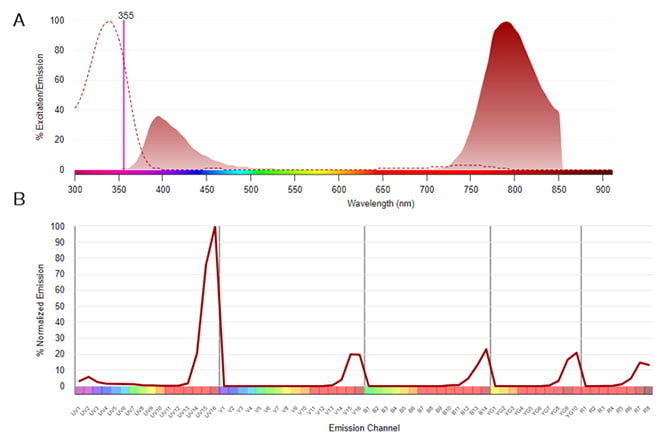
Fig. 19. SBUV795. A, Conventional spectra. Excitation by the ultraviolet laser (dotted line) with emission shown in the shaded histogram. B, Normalized dye signature. Full emission spectrum showing the emission at all wavelengths. Data were collected on a 5-L Cytek Aurora Flow Cytometry System using SpectroFlo Software.
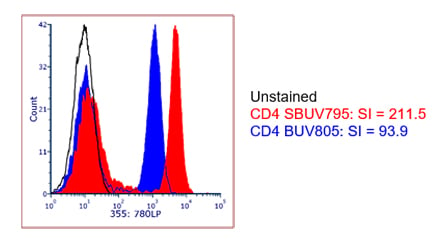
Fig. 20. Brightness comparison. Human peripheral blood was stained with CD4SBUV795 (MCA1267SBUV795) or CD4 BUV805. SBUV795 is brighter than the competitor dye (over 2x). BUV, Brilliant Ultraviolet; SBUV, StarBright UltraViolet; SI, stain index.
SBUV795 is twice as bright as the nearest competitor dye (Figure 20) with a similar spillover profile. Fixable, with no special buffer required and lot-to-lot reproducibility not seen in tandem dyes, SBUV795 can be easily added to existing panels to expand the use of lasers and filters or replace dimmer dyes for enhanced resolution. Examples of SBUV795 staining in human and mouse samples with other fluorescent dyes, including multiplexing with other StarBright Dyes, can be seen in Figure 21.

Fig. 21. Performance of SBUV795. Human peripheral blood was stained with various SBUV795 labeled antibodies and counterstained with a variety of StarBright UltraViolet, StarBright Violet, or Alexa labeled antibodies. Staining was performed in PBS containing 1% BSA with the addition of Fc block.
StarBright UltraViolet Antibodies
| Description | Target | Format | Clone | Applications | Citations | Code |
|---|
Associated Reading
For more information on how the StarBright Dye range can fit into your flow cytometry experiments, please take a look at our StarBright Dyes page.
For more information on how these products can improve the effectiveness of your flow cytometry experiments, please take a look at our flow cytometry explained knowledge hub. Alternatively, feel free to explore the associated resource links below, for more in-depth information about each cited topic. If you are interested in learning the fundamentals of this application, please view our flow cytometry basics guide.




